Performance of Sustainable Insulated Wall Panels with Geopolymer Concrete
Abstract
1. Introduction
2. Materials and Methods
2.1. Binder
2.1.1. Filler
2.1.2. Activator Solution (AS)
2.1.3. Expanded Polystyrene (EPS)
2.1.4. Mix Design
2.2. Methods
2.2.1. Specimen Preparation
2.2.2. Workability Test
2.2.3. Test Setup for Axial Compression Test on ICF
3. Results and Discussion
3.1. Workability
3.2. Compressive Strength (CS)
3.3. Axial Load Deformation of ICF
3.4. Strain Energy
3.5. Crack Pattern
3.6. Cost Efficiency
3.7. Advantages of ICF over Masonry Walls
4. Conclusions
- The encapsulation of concrete in the EPS system changes the failure type from brittle to ductile, and the elastic property of the EPS holds the encapsulated concrete in the core even after the failure;
- The result from the study reveals that Specimen S9 (all the cells of EPS were filled with concrete, M20) exhibits a load of 360 kN with deformation of 11 mm more than the reference masonry unit and all other models;
- In comparison with the reference wall panel, Specimen S2, the load-carrying capacity of Specimen S2 was 3.33% less, whereas the Specimens S3, S4, S5, S6, S7, S8, and S9 gained an increase of 60%, 87%, 57%, 107%, 133%, and 160%, respectively;
- Due to the EPS outer shell, the wall panels possess higher deformations than the conventional brick masonry wall;
- The brick masonry walls exhibit brittle failure; without any sign, the masonry wall fails into pieces, whereas the ICF wall panels retain their shape even after failure. Therefore, ICF can be recommended to replace the conventional load-bearing and non-load-bearing walls;
- Research on the carbon and energy-effective mix design proportion of GPC-based ICF to attain target strength, workability, durability, and sustainability may be carried out. Further investigations are required to elaborately explain the failure pattern, loading-deflection behavior, material characterization of EPS, and the infilling materials so that national standards/guidelines can be developed.
Author Contributions
Funding
Institutional Review Board Statement
Informed Consent Statement
Data Availability Statement
Conflicts of Interest
References
- Assaad, J.J.; Mikhael, C.; Hanna, R. Recycling of Waste Expanded Polystyrene Concrete in Lightweight Sandwich Panels and Structural Applications. Clean. Mater. 2022, 4, 100095. [Google Scholar] [CrossRef]
- Meddage, D.P.P.; Chadee, A.; Jayasinghe, M.T.R.; Rathnayake, U. Exploring the Applicability of Expanded Polystyrene (EPS) Based Concrete Panels as Roof Slab Insulation in the Tropics. Case Stud. Constr. Mater. 2022, 17, e01361. [Google Scholar] [CrossRef]
- Souza, T.B.; Lima, V.M.E.; Araújo, F.W.C.; Miranda, L.F.R.; Melo Neto, A.A. Alkali-Activated Slag Cellular Concrete with Expanded Polystyrene (EPS)—Physical, Mechanical, and Mineralogical Properties. J. Build. Eng. 2021, 44, 103387. [Google Scholar] [CrossRef]
- Garhwal, A.; Sharma, S.; Roy, A.B.D. Performance of Expanded Polystyrene (EPS) Sandwiched Concrete Panels Subjected to Accelerated Corrosion. Structures 2022, 43, 1057–1072. [Google Scholar] [CrossRef]
- Jiang, T.; Wang, Y.; Shi, S.; Yuan, N.; Ma, R.; Wu, X.; Shi, D.; Sun, K.; Zhao, Y.; Li, W.; et al. Compressive Behavior of Lightweight Concrete Using Aerogel-Reinforced Expanded Polystyrene Foams. Case Stud. Constr. Mater. 2022, 17, e01557. [Google Scholar] [CrossRef]
- Maghfouri, M.; Alimohammadi, V.; Gupta, R.; Siberian, M.; Azaria, P.; Hashemi, M.; Asadi, I.; Roychand, R. Drying Shrinkage Properties of Expanded Polystyrene (EPS) Lightweight Aggregate Concrete: A Review. Case Stud. Constr. Mater. 2022, 16, e00919. [Google Scholar] [CrossRef]
- Khatib, J.; Jahami, A.; Baalbaki, O. Flexural Characteristics of Reinforced Concrete Beams Containing Lightweight Aggregate in the Tensile Zone. Sustain. Constr. Mater. Technol. 2019, 1–9. [Google Scholar] [CrossRef]
- Jiang, P.; Chen, Y.; Li, N.; Zhou, L.; Pu, S.; Wang, W. Strength Properties and Microscopic Mechanism of Lime and Fly Ash Modified Expandable Poly Styrene Lightweight Soil Reinforced by Polypropylene Fiber. Case Stud. Constr. Mater. 2022, 17, e01250. [Google Scholar] [CrossRef]
- Mochalov, A.M.; Akulova, M.V.; Sokolova, J.A.; Sokolova, A.G. New Flame-Retardant Composition for Lowering Contribution of Expanded Poly Styrene to the Propagation of Fire. IOP Conf. Ser. Mater. Sci. Eng. 2021, 1015, 012064. [Google Scholar] [CrossRef]
- Ding, F.; Wu, X.; Xiang, P.; Yu, Z. New Damage Ratio Strength Criterion for Concrete and Lightweight Aggregate Concrete. ACI Struct. J. 2021, 118, 165–178. [Google Scholar] [CrossRef]
- Ekrami, N.; Garat, A.; Fung, A.S. Thermal Analysis of Insulated Concrete Form (ICF) Walls. Energy Procedia 2015, 75, 2150–2156. [Google Scholar] [CrossRef]
- Arun Solomon, A.; Hemalatha, G. Characteristics of Expanded Polystyrene (EPS) and Its Impact on Mechanical and Thermal Performance of Insulated Concrete Form (ICF) System. Structures 2020, 23, 204–213. [Google Scholar] [CrossRef]
- Lopez, A.; Bazaez, R.; Leiva, G.; Loyola, R.; Gómez, M. Experimental Study of In-Plane Flexural Behavior of Screen-Grid Insulated Concrete Form Rectangular and T-Shaped Walls. Eng. Struct. 2021, 247, 113128. [Google Scholar] [CrossRef]
- Arun Solomon, A.; Hemalatha, G.; Sudheer, G.; Shelton, J.; Carmichael, J. Exploring the Impact of EPS Incorporation on Insulated Concrete Form (ICF) Wall Panels under Axial Compression and Flexure. J. King Saud Univ.-Eng. Sci. 2022, in press. [Google Scholar] [CrossRef]
- Lowe, D.; Roy, K.; Das, R.; Clifton, C.; Lim, J. Full-scale experiments on splitting behaviour of concrete slabs in steel-concrete composite beams with shear stud connection. Structures 2020, 23, 126–138. [Google Scholar] [CrossRef]
- Rajamony Laila, L.; Gurupatham, B.G.A.; Roy, K.; Lim, J.B.P. Effect of Super Absorbent Polymer on Microstructural and Mechanical Properties of Concrete Blends Using Granite Pulver. Struct. Concr. 2020, 22, E898–E915. [Google Scholar] [CrossRef]
- Rajamony Laila, L.; Gurupatham, B.G.A.; Roy, K.; Lim, J.B.P. Influence of Super Absorbent Polymer on Mechanical, Rheological, Durability, and Microstructural Properties of Self-Compacting Concrete Using Non-Biodegradable Granite Pulver. Struct. Concr. 2020, 22, E1093–E1116. [Google Scholar] [CrossRef]
- Moro, C.; Francioso, V.; Velay-Lizancos, M. Impact of Nano-TiO2 Addition on the Reduction of Net CO2 Emissions of Cement Pastes after CO2 Curing. Cem. Concr. Compos. 2021, 123, 104160. [Google Scholar] [CrossRef]
- Ndahirwa, D.; Zmamou, H.; Lenormand, H.; Leblanc, N. The Role of Supplementary Cementitious Materials in Hydration, Durability and Shrinkage of Cement-Based Materials, Their Environmental and Economic Benefits: A Review. Clean. Mater. 2022, 5, 100123. [Google Scholar] [CrossRef]
- Kanagaraj, B.; Anand, N.; Andrushia, A.D.; Lubloy, E. Investigation on Engineering Properties and Micro-Structure Characteristics of Low Strength and High Strength Geopolymer Composites Subjected to Standard Temperature Exposure. Case Stud. Constr. Mater. 2022, 17, e01608. [Google Scholar] [CrossRef]
- Madan, C.S.; Munuswamy, S.; Joanna, P.S.; Gurupatham, B.G.A.; Roy, K. Comparison of the Flexural Behavior of High-Volume Fly Ash Based Concrete Slab Reinforced with GFRP Bars and Steel Bars. J. Compos. Sci. 2022, 6, 157. [Google Scholar] [CrossRef]
- Madan, C.S.; Panchapakesan, K.; Anil Reddy, P.V.; Joanna, P.S.; Rooby, J.; Gurupatham, B.G.A.; Roy, K. Influence on the Flexural Behaviour of High-Volume Fly-Ash-Based Concrete Slab Reinforced with Sustainable Glass-Fibre-Reinforced Polymer Sheets. J. Compos. Sci. 2022, 6, 169. [Google Scholar] [CrossRef]
- Chinnasamy, Y.; Joanna, P.S.; Kothanda, K.; Gurupatham BG, A.; Roy, K. Behavior of Pultruded Glass-Fiber-Reinforced Polymer Beam-Columns Infilled with Engineered Cementitious Composites under Cyclic Loading. J. Compos. Sci. 2022, 6, 338. [Google Scholar] [CrossRef]
- Sivanantham, P.; Gurupatham, B.G.A.; Roy, K.; Rajendiran, K.; Pugazhlendi, D. Plastic Hinge Length Mechanism of Steel-Fiber-Reinforced Concrete Slab under Repeated Loading. J. Compos. Sci. 2022, 6, 164. [Google Scholar] [CrossRef]
- Kanagaraj, B.; Anand, N.; Lubloy, E. Performance Evaluation of Sodium Silicate Waste as a Replacement for Conventional Sand in Geopolymer Concrete. J. Clean. Prod. 2022, 375, 134172. [Google Scholar] [CrossRef]
- Prusty, J.K.; Pradhan, B. Investigation on Effect of Precursor Materials and Sand-to-Binder Ratio on Strength Development, Acid Resistance and Microstructure Evolution of Geopolymer Mortar. Constr. Build. Mater. 2022, 346, 128501. [Google Scholar] [CrossRef]
- Qaidi, S.M.A.; Sulaiman Atrushi, D.; Mohammed, A.S.; Unis Ahmed, H.; Faraj, R.H.; Emad, W.; Tayeh, B.A.; Mohammed Najm, H. Ultra-High-Performance Geopolymer Concrete: A Review. Constr. Build. Mater. 2022, 346, 128495. [Google Scholar] [CrossRef]
- Wu, H.C.; Sun, P. New Building Materials from Fly Ash-Based Lightweight Inorganic Polymer. Constr. Build. Mater. 2007, 21, 211–217. [Google Scholar] [CrossRef]
- Ahmad, A.; Singh, Y. Flexural Behavior of Expanded Polystyrene Core Reinforced Concrete Sandwich Panels with Different Construction Methods and End Conditions. Structures 2021, 34, 2900–2911. [Google Scholar] [CrossRef]
- Kanagaraj, B.; Anand, N.; Johnson Alengaram, U.; Samuel Raj, R.; Kiran, T. Exemplification of Sustainable Sodium Silicate Waste Sediments as Coarse Aggregates in the Performance Evaluation of Geopolymer Concrete. Constr. Build. Mater. 2022, 330, 127135. [Google Scholar] [CrossRef]
- IS 383; Coarse and Fine Aggregate for Concrete-Specification. Bureau of Indian Standards: New Delhi, India, 2016.
- Kanagaraj, B.; Kiran, T.; Anand, N.; Al Jabri, K.; Justin, S. Development and Strength Assessment of Eco-Friendly Geopolymer Concrete Made with Natural and Recycled Aggregates. Constr. Innov. 2022. ahead-of-print. [Google Scholar] [CrossRef]
- Kanagaraj, B.N.A.; Kiran, T.; Prince, A.S.J. Experimental Investigation on Fresh and Hardened Properties of Geopolymer Concrete Blended with Recycled Concrete Aggregate. Indian Concr. J. 2022, 96, 29–41. [Google Scholar]
- Kanagaraj, B.; Anand, N.; Samuel Raj, R.; Lubloy, E. Performance Evaluation on Engineering Properties of Sodium Silicate Binder as a Precursor Material for the Development of Cement-Free Concrete. Dev. Built Environ. 2022, 12, 100092. [Google Scholar] [CrossRef]
- Kanagaraj, B.; Anand, N.; Alengaram, U.J.; Praveen, B.; Tattukolla, K. Performance Evaluation on Engineering Properties and Sustainability Analysis of High Strength Geopolymer Concrete. J. Build. Eng. 2022, 60, 105147. [Google Scholar] [CrossRef]
- Fang, Z.; Roy, K.; Chi, Y.; Chen, B.; Lim, J.B.P. Finite element analysis and proposed design rules for cold-formed stainless steel channels with web holes under end-one-flange loading. Structures 2021, 34, 2876–2899. [Google Scholar] [CrossRef]
- ASTM C 143; Standard Test Method for Slump of Hydraulic-Cement Concrete. ASTM International: West Conshohocken, PA, USA, 2014. [CrossRef]
- IS 516; Method of Tests for Strength of Concrete-Specifications. Bureau of Indian Standards: New Delhi, India, 2004.
- Darvish, P.; Johnson Alengaram, U.; Soon Poh, Y.; Ibrahim, S.; Yusoff, S. Performance Evaluation of Palm Oil Clinker Sand as Replacement for Conventional Sand in Geopolymer Mortar. Constr. Build. Mater. 2020, 258, 120352. [Google Scholar] [CrossRef]



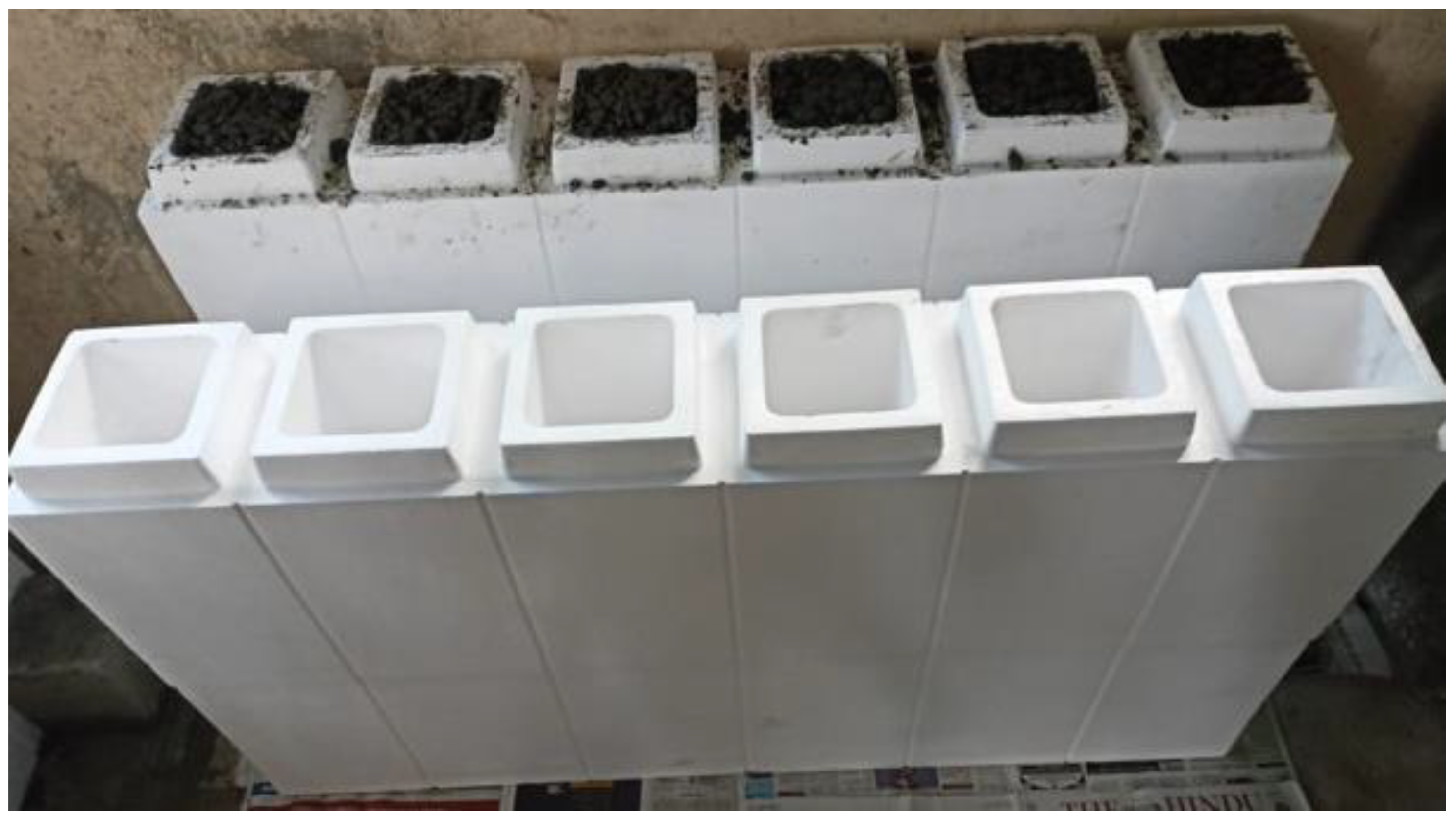
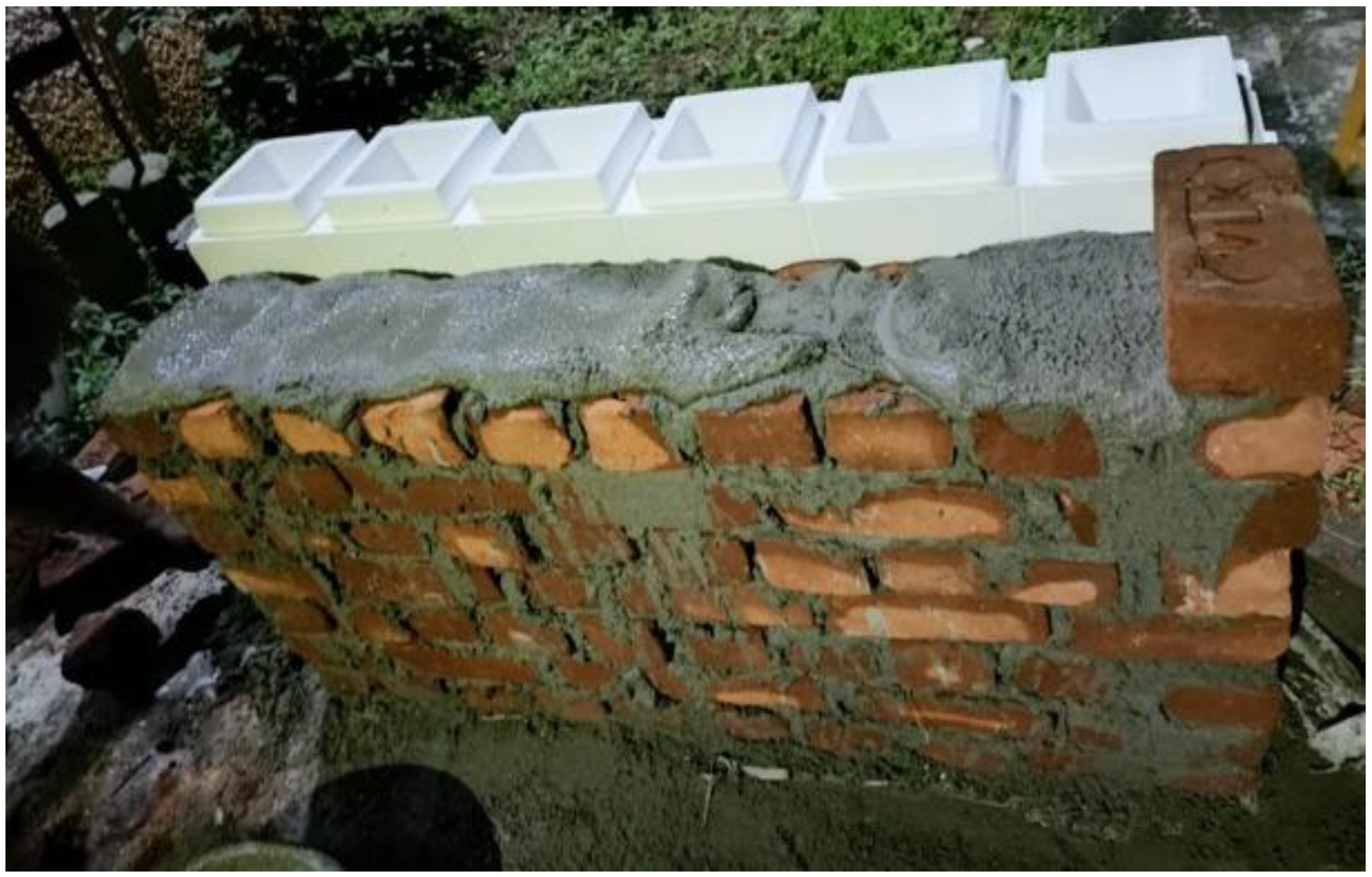
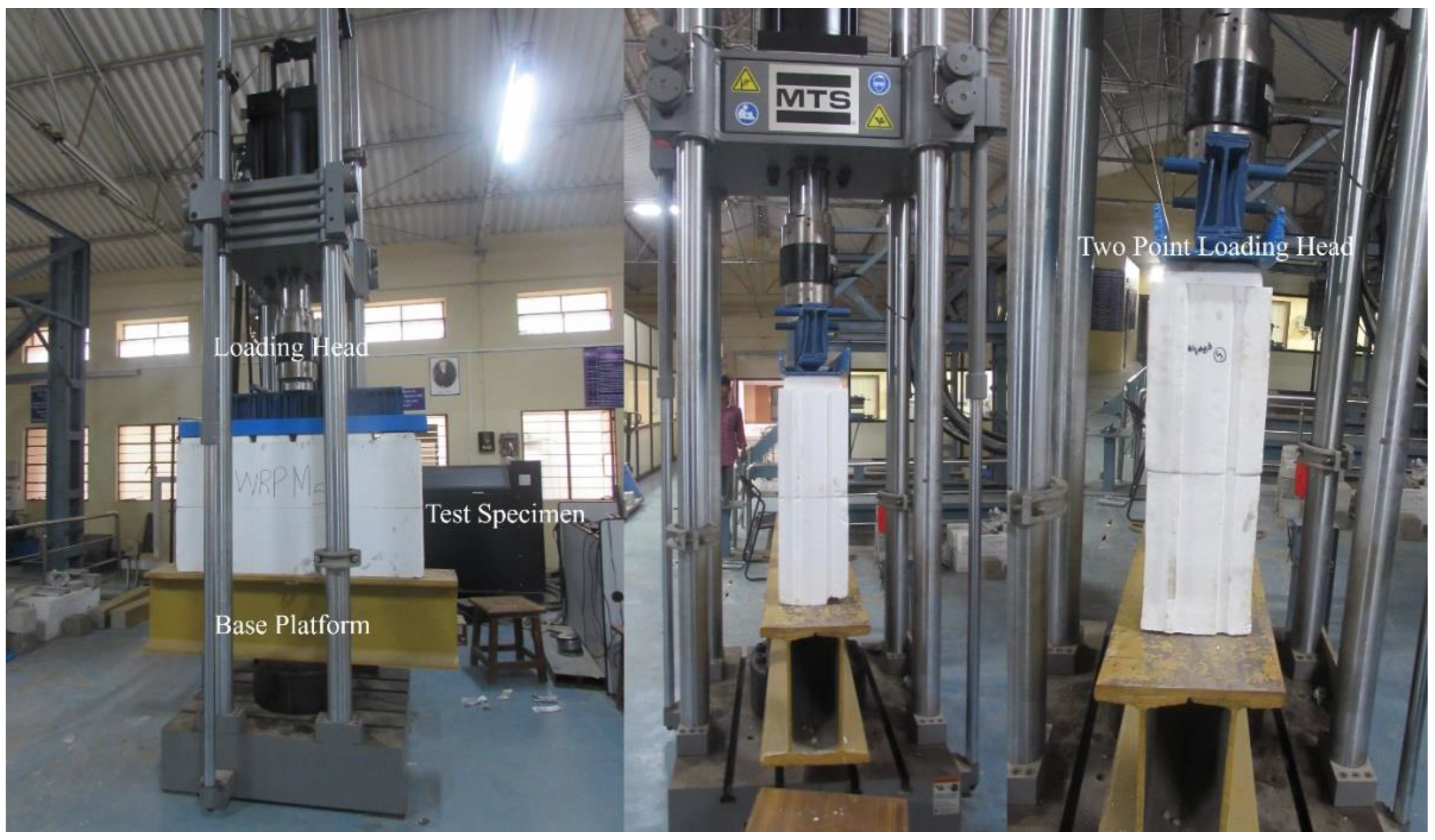
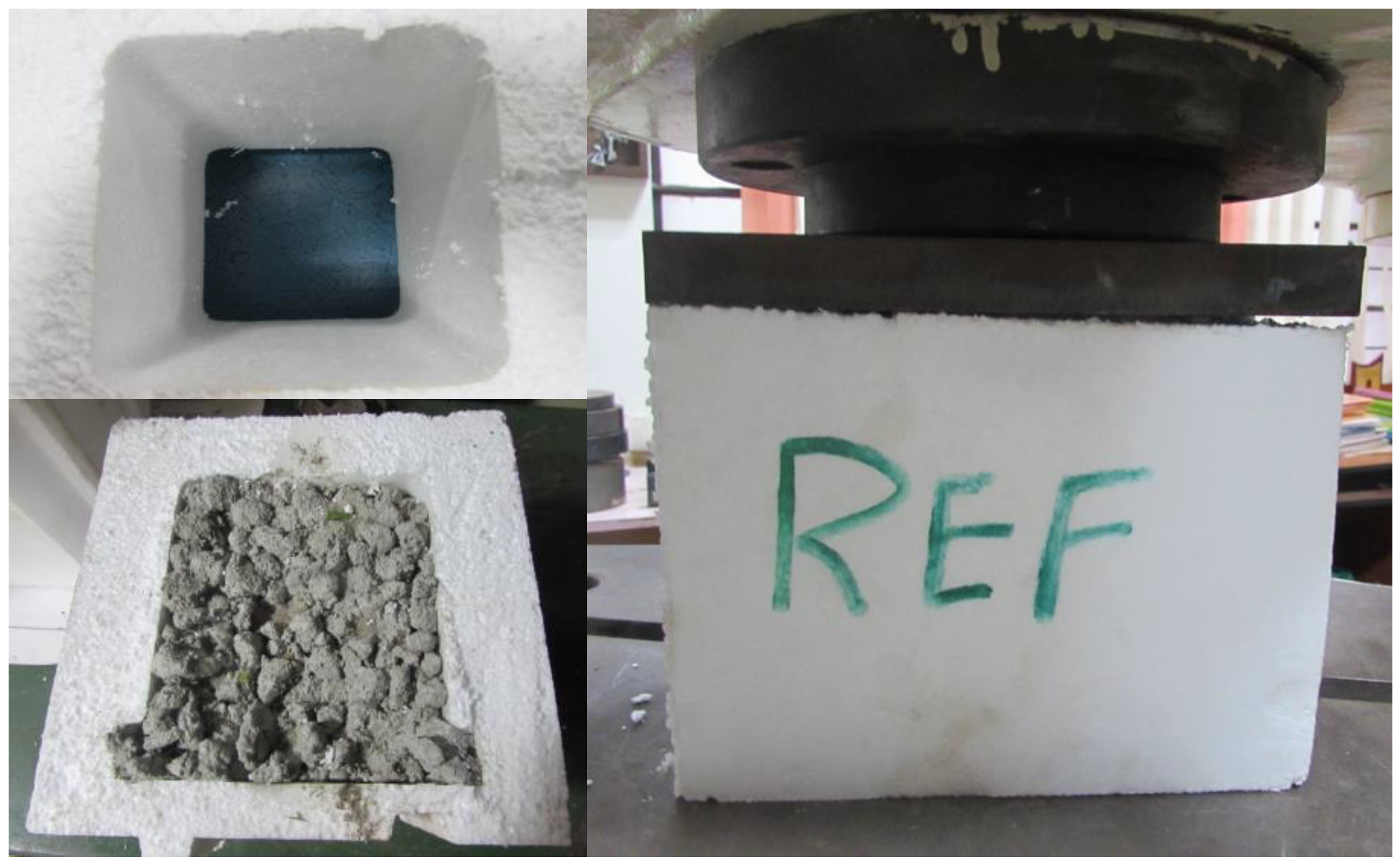
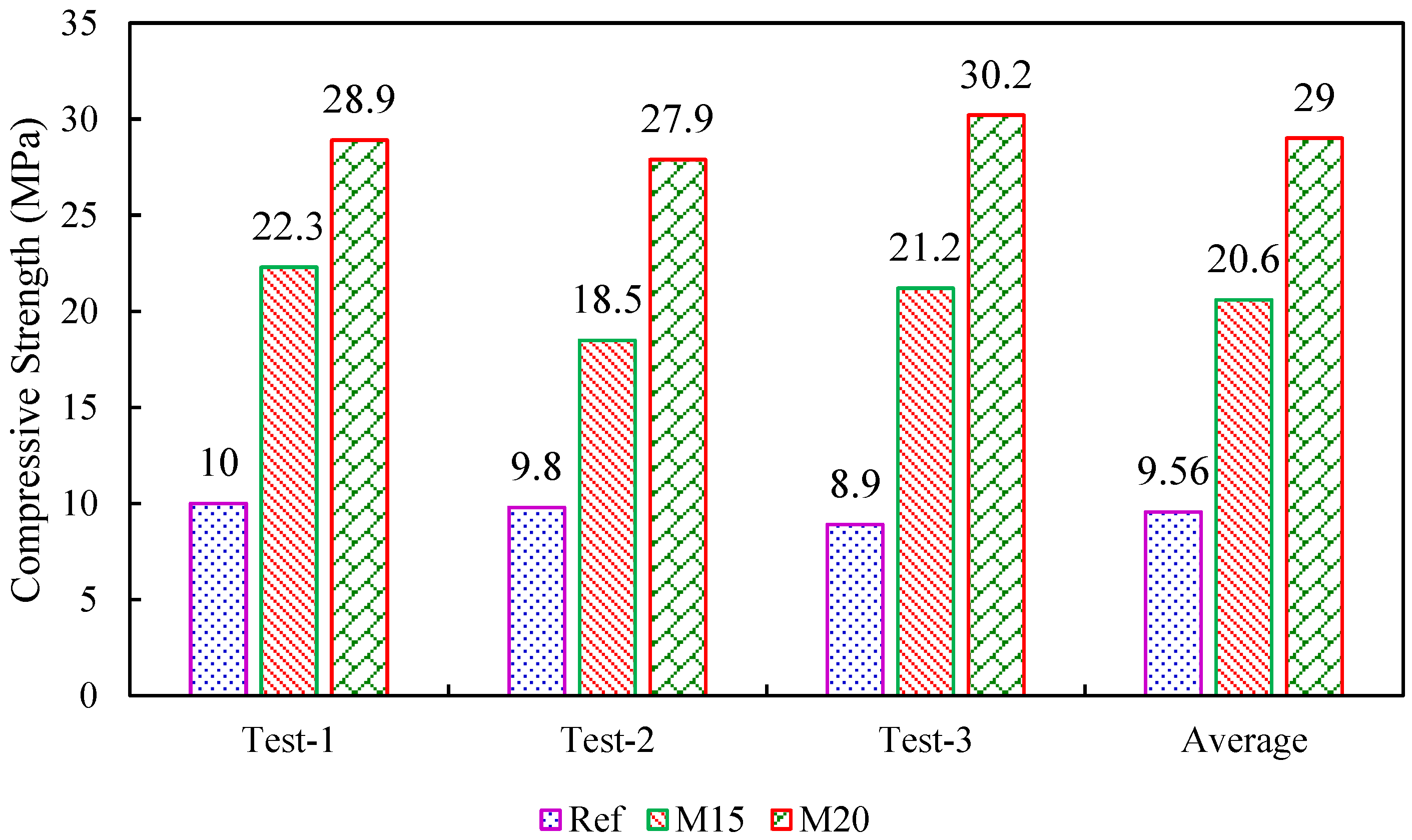

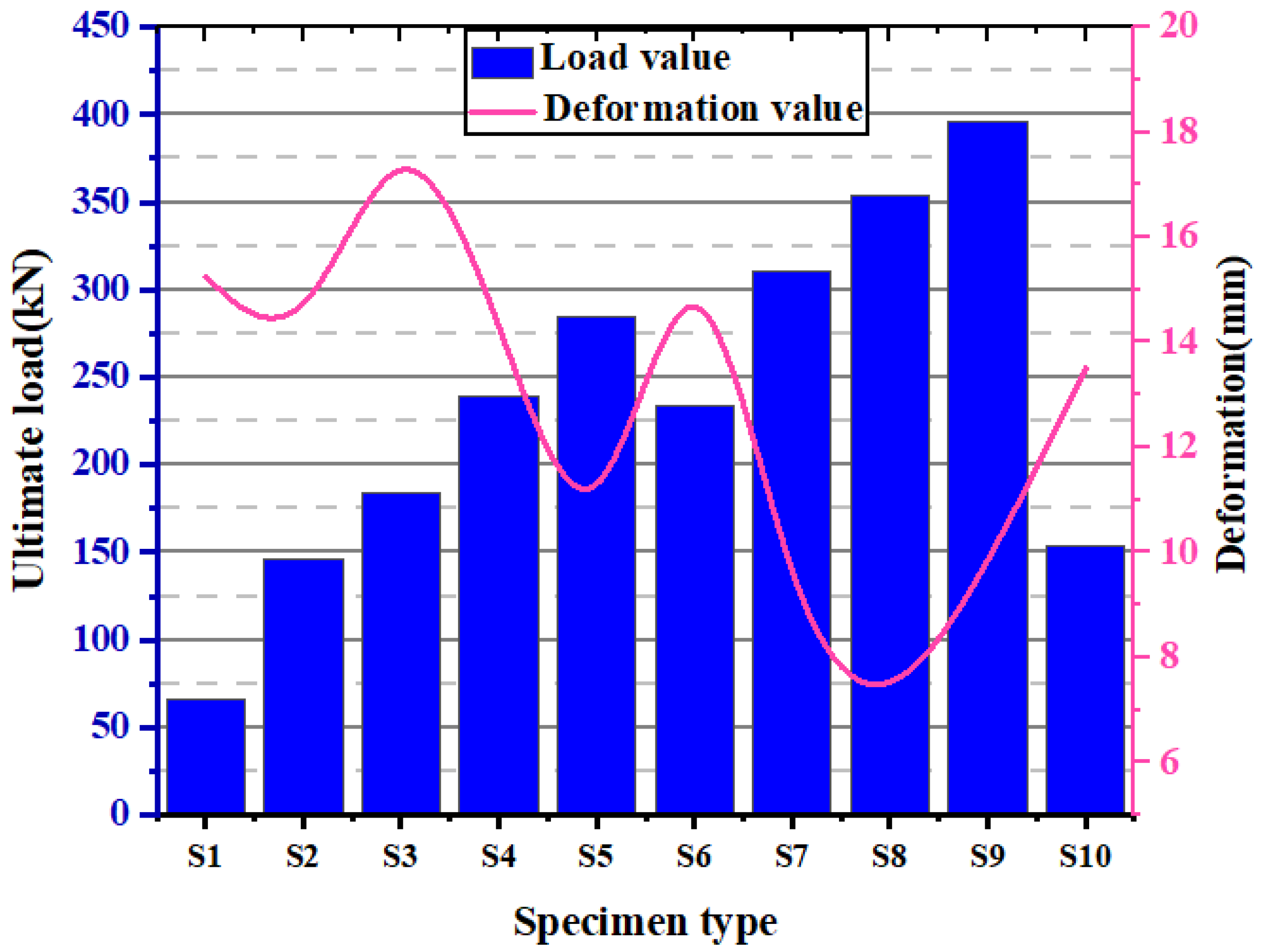
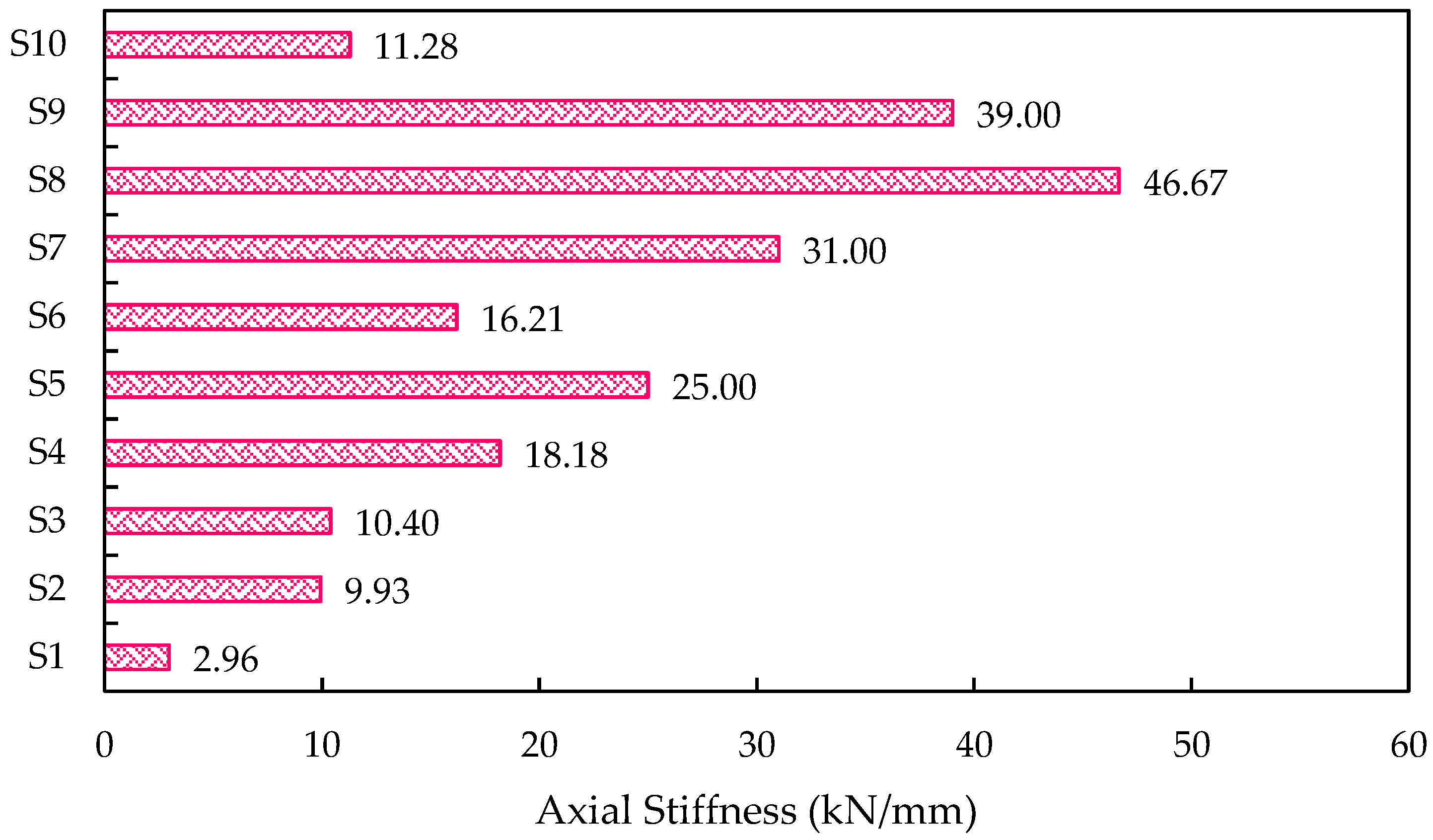


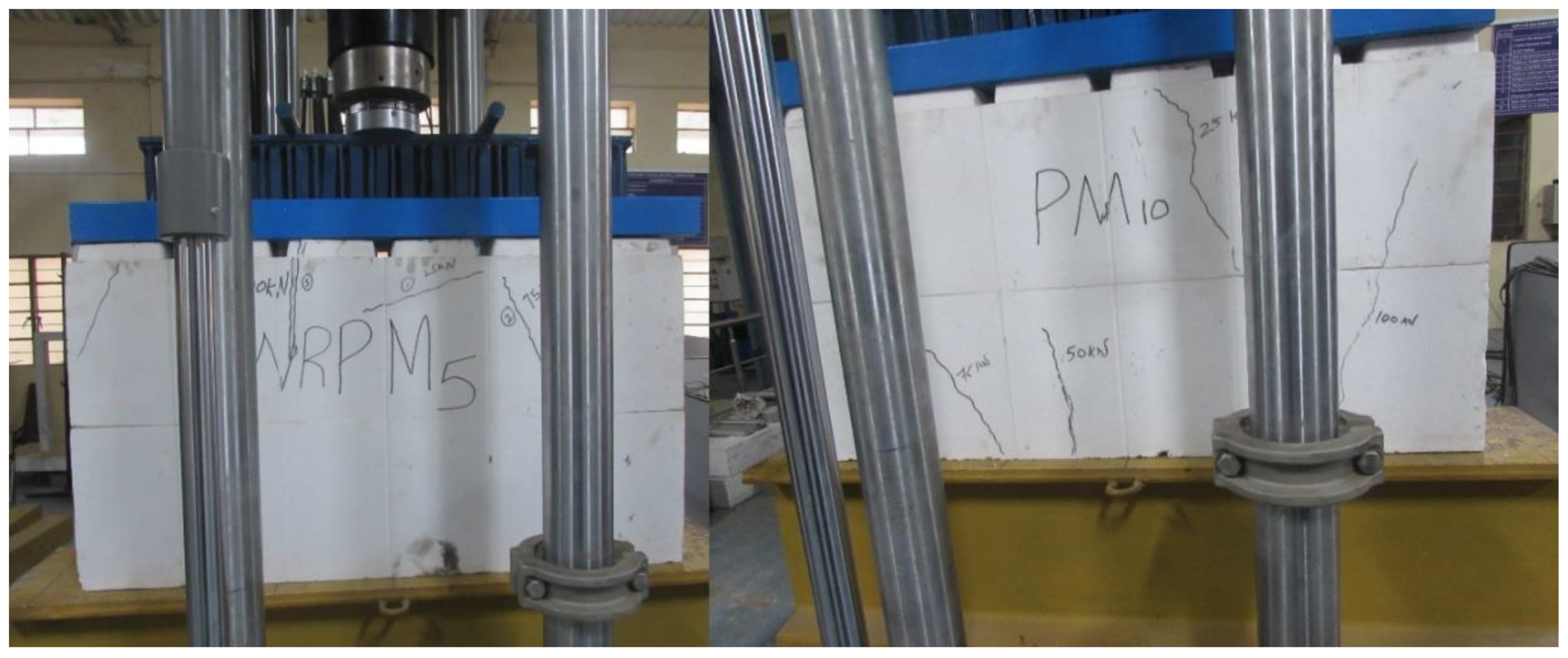
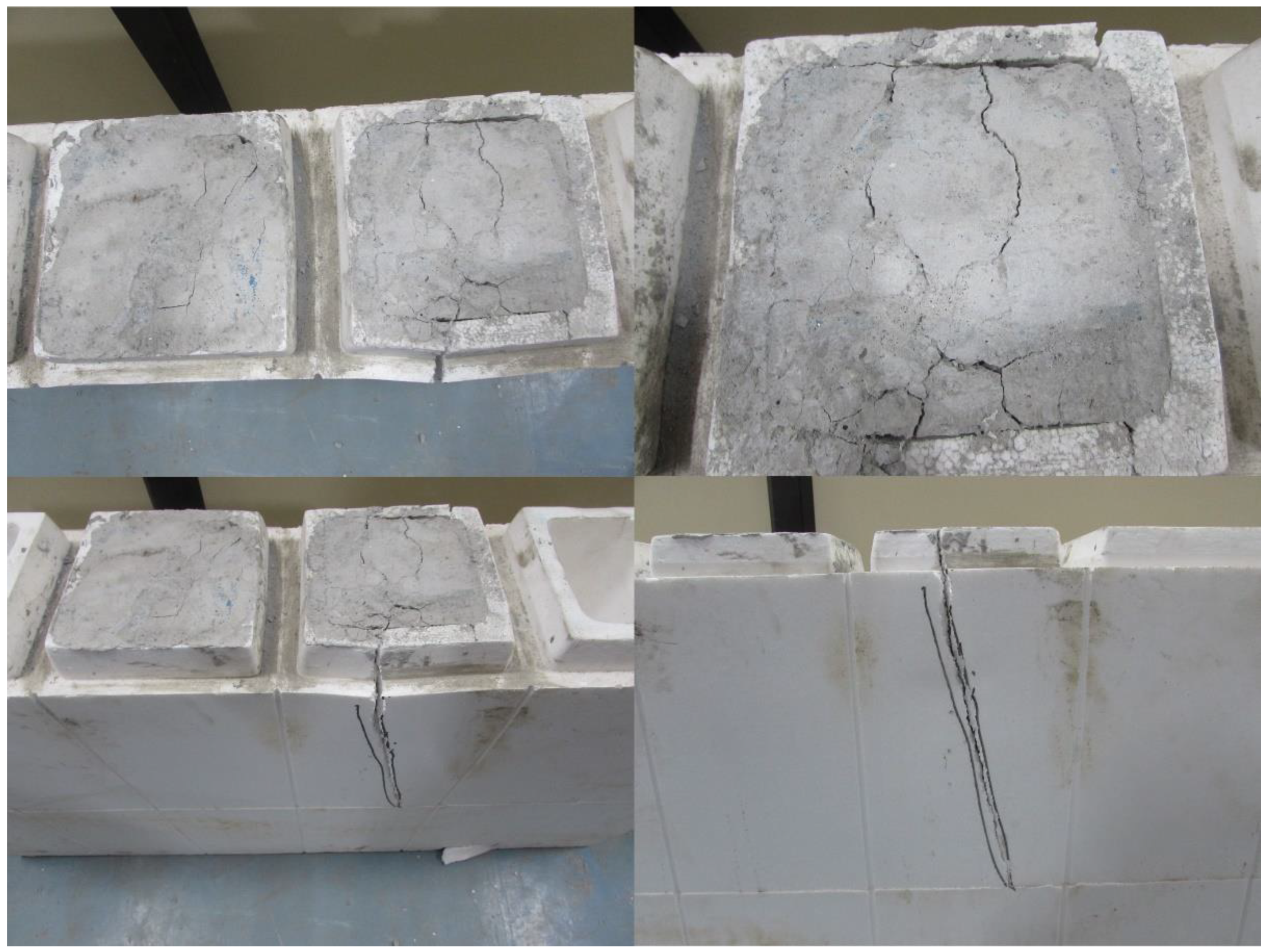
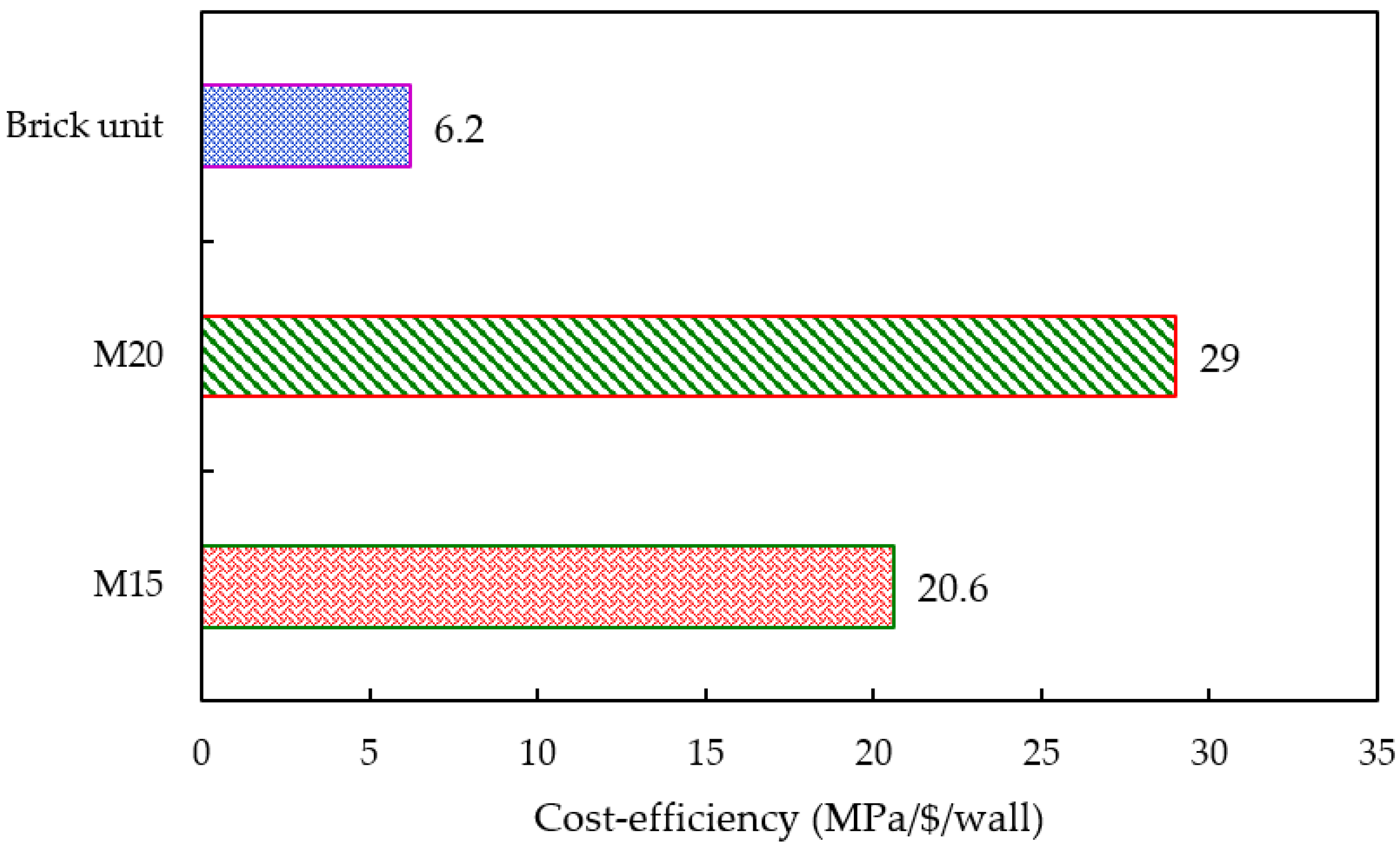
| Oxides | FA (%) | GGBFS (%) |
|---|---|---|
| SiO2 | 61.2 | 42.4 |
| Al2O3 | 26.9 | 13.2 |
| Fe2O3 | 6.21 | 1.12 |
| CaO | 1.91 | 41.2 |
| MgO | 0.29 | 1.3 |
| Na2O | 0.58 | 0.3 |
| K2O | 1.21 | 0.7 |
| Ti | 0.4 | - |
| Specification | Material Properties |
|---|---|
| Size of the ICF wall | 20.32 cm (8 inches) × 30.50 cm (12 inches) × 121.00 cm (48 inches) |
| Water vapor Permeability | 0.0020 ng·s·m2·Pa |
| Moisture Absorption (humidity):% mass | 0.4417 |
| Moisture Absorption (humidity):% volume | 0.0099 |
| Type of Mix | Binder | Aggregate (kg/m3) | Alkaline Activator (kg/m3) | Molarity (M) | |||
|---|---|---|---|---|---|---|---|
| (kg/m3) | |||||||
| FA | GGBS | M-Sand | Coarse | NH | NS | ||
| M15 | 180 | 20 | 450 | 650 | 28.96 | 43.44 | 4 |
| M20 | 100 | 100 | 450 | 650 | 28.96 | 43.44 | 4 |
| Specimen Type | Reinforcement Type | Specimen Description | Type of Mix |
|---|---|---|---|
| S1 | (Without reinforcement) | Hollow EPS without concrete | - |
| S2 | Alternative cells of EPS were filled with concrete | M15 | |
| S3 | All the cells of EPS were filled with concrete | M15 | |
| S4 | Alternative cells of EPS were filled with concrete | M20 | |
| S5 | All the cells of EPS were filled with concrete | M20 | |
| S6 | (With reinforcement) | Alternative cells of EPS were filled with concrete | M15 |
| S7 | All the cells of EPS were filled with concrete | M15 | |
| S8 | Alternative cells of EPS were filled with concrete | M20 | |
| S9 | All the cells of EPS were filled with concrete | M20 | |
| S10 | Masonry (reference) | - |
| S.No | Material | ICF | Brick Wall | |||||
|---|---|---|---|---|---|---|---|---|
| M15 | M20 | |||||||
| Rate | QTY | Cost | QTY | Cost | QTY | Cost | ||
| (USD/MT) | (1 Wall) | (USD/Wall) | (1 Wall) | (USD/Wall) | (1 Wall) | (USD/Wall) | ||
| 1 | Cement | 134.91 | - | - | - | - | 30 | 4.05 |
| 2 | FA | 13.49 | 180 | 2.43 | 100 | 1.35 | - | - |
| 3 | GGBS | 78.6 | 20 | 1.57 | 100 | 7.86 | - | - |
| 4 | CA | 9.44 | 650 | 6.14 | 350 | 3.30 | - | - |
| 5 | MS | 7.55 | 450 | 3.40 | 450 | 3.40 | 60 | 0.45 |
| 6 | SS | 121.41 | 43.44 | 5.27 | 43.44 | 5.27 | - | - |
| 7 | SH | 303.33 | 28.96 | 8.78 | 28.96 | 8.78 | - | - |
| 8 | Bricks | 0.15/brick | - | - | - | - | 275 | 41.25 |
| 9 | ICF panel | 10/panel | 2 | 20 | 2 | 20 | - | - |
| 10 | Total Cost USD/wall | 47.59 | 49.97 | 45.75 | ||||
| 11 | 28 days compressive strength (MPa) | 20.60 | 29.00 | 6.20 | ||||
| 12 | Cost efficiency (MPa/USD/wall) | 0.43 | 0.58 | 0.14 | ||||
Publisher’s Note: MDPI stays neutral with regard to jurisdictional claims in published maps and institutional affiliations. |
© 2022 by the authors. Licensee MDPI, Basel, Switzerland. This article is an open access article distributed under the terms and conditions of the Creative Commons Attribution (CC BY) license (https://creativecommons.org/licenses/by/4.0/).
Share and Cite
Kanagaraj, B.; Kiran, T.; Gunasekaran, J.; Nammalvar, A.; Arulraj, P.; Gurupatham, B.G.A.; Roy, K. Performance of Sustainable Insulated Wall Panels with Geopolymer Concrete. Materials 2022, 15, 8801. https://doi.org/10.3390/ma15248801
Kanagaraj B, Kiran T, Gunasekaran J, Nammalvar A, Arulraj P, Gurupatham BGA, Roy K. Performance of Sustainable Insulated Wall Panels with Geopolymer Concrete. Materials. 2022; 15(24):8801. https://doi.org/10.3390/ma15248801
Chicago/Turabian StyleKanagaraj, Balamurali, Tattukolla Kiran, Jayakumar Gunasekaran, Anand Nammalvar, Prince Arulraj, Beulah Gnana Ananthi Gurupatham, and Krishanu Roy. 2022. "Performance of Sustainable Insulated Wall Panels with Geopolymer Concrete" Materials 15, no. 24: 8801. https://doi.org/10.3390/ma15248801
APA StyleKanagaraj, B., Kiran, T., Gunasekaran, J., Nammalvar, A., Arulraj, P., Gurupatham, B. G. A., & Roy, K. (2022). Performance of Sustainable Insulated Wall Panels with Geopolymer Concrete. Materials, 15(24), 8801. https://doi.org/10.3390/ma15248801








